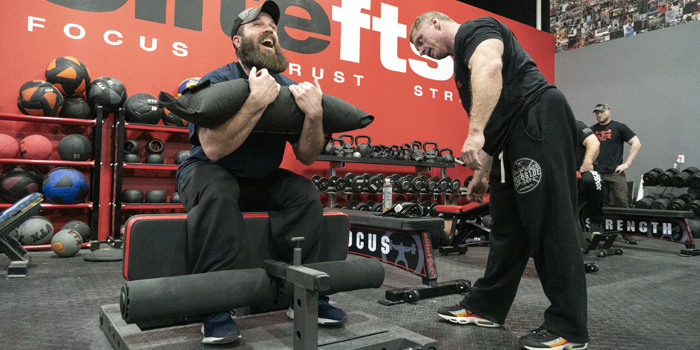
There is an encyclopedia of articles, debates, and theories when it comes to building muscle. But, anyone who wants to be strong and big must first realize there isn't a one-size-fits-all option to pack on muscle.
Here are three of my favorite intensity techniques to add muscle that naturally cut training time: rest-pause sets, isometric pre/post fatigue sets, and cluster sets.
Understand why they work, who they're for, and how to program them.
Rest-Pause Sets
You'll use a weight in which you can get six to 10 reps close to failure. You will then perform as many good reps as you can with that weight, rest 10-15 seconds, then try to get as many reps as possible.
You can also use rest-pause sets with heavier loads and longer rests.
The only caveat to this method is anticipating the future sets, therefore "saving" energy. It creates an intensity range that might not suggest its true potential to be as good as a standard set to failure when done correctly.
I suggest having a training age that allows you to truly know what failure is for a certain lift.
Why Rest-Pause Sets Work
It helps for both muscle and strength gains because you can maintain high motor unit recruitment. It also allows you to use the same weight for each set where drop sets have the weight decrease.
Some studies have shown it to boost muscular endurance.
Who's it For?
In my opinion, rest-pause sets work well for ego-driven guys who like to push themselves to true failure. It can be a great way to get volume days in while increasing high motor units. You will increase work capacity with the minimal rest, which can be great for the gym rats who love to test their limits.
Additionally, I find it great for people who need shorter workouts and are in their 40s and 50s with busy lives and careers—heavier loading is not suitable for their lifestyle. It can give them a sense of strength without the tax of heavier loads.
How to Program Rest-Pause Sets
- For those short on time, Rest-Pause Sets are a HUGE time saver. You can creep volume rather quickly and be in and out of the gym with your lungs and muscles burning.
- Great to sprinkle in on higher volume days or on lifts you normally go heavier for maximal effort days. Adding them in for higher volume can give you a new training stimulus to get more results and break the boredom of conventional bodybuilding.
- Use Rest-Pause Sets to add in a microcycle in the third week or after a full six- to eight-week block to break a plateau before starting a new cycle.
- Avoid doing them too much as they tap into more central nervous system fatigue, especially if performing compound lifts.
Isometric Pre/Post-Fatigue
For those with lagging muscles, this one is for you. Isometric Pre/Post-Fatigue is one of my favorite ways to improve mind-muscle connection. The common phrase is "making light weight feel heavy."
Not only is isometric pre/post-fatigue great for hypertrophy, but it delivers high degrees of tension. The key is to start your exercise in a 10- to 20-second hold at the point of highest tension. Conversely, you would do the isometric after the set for post fatigue.
An isometric muscle action refers to exerting muscle tension without producing an actual movement or changing muscle length. An example could be holding a weight at a certain position in the range of motion.
Pre-Fatigue Iso
Pre-Iso Plyometric
Post Iso + Drop Set to Band Pull Aparts
Interestingly, a recent study comparing the level of muscle activation during isometric, concentric, and eccentric muscle actions found that a person can recruit over 5% more motor units/muscle fibers during a maximal isometric muscle action than during either a maximal eccentric (lowering) or maximal concentric (lifting) action; that's 95.2% for isometric compared to 88.3% for the eccentric and 89.7% for the concentric. (1)
These findings are in accordance with the body of literature that finds that a person can recruit almost all motor units during a maximal isometric action. (2)
After the hold, do six to ten reps without any rest and go close to failure. Another important thing to note is making sure you SQUEEZE the peak contraction and not just hold the position. It's easy to pinpoint weak points or spots that tend to "take over" when holding isometrics, so it's wonderful for addressing weak points.
Why Isometric Pre/Post-Fatigue Works
Isometric training can improve our capacity to recruit motor units during a maximal contraction. This improved neural drive could greatly increase one's strength production potential in the long run!
A study by Kanchisa et al. (2002) found an average muscle cross-sectional area (size) improvement of 12.4% for maximal isometric contraction training and of 5.3% for isometric training at 60% of maximum contraction after a training period of ten weeks. The authors attributed the gain in muscle size to metabolic demands and endocrine activities rather than mechanical stress and neuromuscular control.
Who's it For?
Although popular to help athlete's in their field of sport to recruit high levels of motor units and improve that mind-muscle connection via tension, it doesn't mean bodybuilders can't get growth from it. Studies have shown it's possible, but not something you want to replace long term with your current program.
Now, if you're like me, you might get eager to test isometrics and their abilities. For this, I love doing combination isometrics. The Bulgarian Isometric Press fits this bill perfectly!
The Benefits
Core Stability: Trying to balance the load distribution on one leg is MUCH harder than it looks. Your core works overtime!
Dialed in Scapular Upward Rotation: Something many need, and the Landmine attachment allows for a free moving scapula in a safer position that enables you to get overhead.
Single-Leg Strength: Think squats are hard? Try balancing on one leg in the bottom of an isometric with 100 pounds overhead.
How to Program Isometrics
Do isometrics in short blocks of a couple of weeks, hitting weaker parts of your body. Not much research shows continued growth after a short period, so I find them best used when more force production is needed or when training with low volumes from injuries, fatigue, or time constraints. The motor firing and time under tension have been shown to prolong strength gains.
Stick to better exercises for isolation, like biceps, triceps, and delts.
Cluster Sets
Cluster sets are built within small rests of anywhere from five-30 seconds. You can call them "micro sets." Cluster sets allow for motor unit synchronization, high levels of muscular force, and the recruitment of high-threshold motor units without fatigue. Heavier weights for more reps give us bigger muscles and more work capacity.
Strength clusters differ from size clusters in a few ways.
Rather than increasing volume and decreasing rest intra-set, we'll hold each variable constant. To boost strength, we'll increase load and place the clusters secondary to the main loading parameter of the main lift. You hit the main good stuff, and then you'll increase the load.
Accumulating fatigue may be beneficial for producing gains in muscle mass. So for the purpose of hypertrophy, you may want to pursue shorter intra-set rest periods.
Recommended Intra-set Rest Periods are: 5 to 20 seconds
Recommended Inter-set Rest Periods are: 1 to 2 minutes
You can also take intensities that you would normally reserve for low reps and use them for cluster sets and attempt to get more reps.
Recommended Intensity Range: 6RM to 10RM
Deadlift (Standard Cluster Sets)
3 x 3,2,1 @ 5RM or 90%
Prescription: Perform 3 sets of 6 rep cluster sets, with each cluster set being constructed smaller rep sets
Rest: Take 20 seconds of rest in between mini-sets. Take 3-5 minutes after cluster set
How to Program Cluster Sets
1. Standard Cluster Sets
Standard cluster sets are written in the format of:
• (Sets) x (total reps in 1 cluster set) / (reps in each mini-set)
• E.g. 3×6/2 is 3 sets of 6 reps with 2 rep clusters
2. Undulating Cluster Sets
Undulating cluster sets incorporate a rise in load, followed by a fall in load.
This can be performed in a single pyramid. Alternatively, the wave loading can oscillate more frequently where the load goes up and down several times within a cluster set.
Undulating cluster sets give you the opportunity to gain exposure to higher intensities without overdoing them by incorporating lower intensities as well.
3. Ascending Cluster Sets
Ascending cluster sets involve a continuous increase in loading after each intraset rest period but without going back down. They allow you to increase loading compared to straight sets by taking advantage of the intra-set rest period.
Another example I like would be doing your standard three to four sets at a given load, then going right into your clusters for an additional one to two work sets where you increase the volume by breaking it up.
Ex. 3x8, then 2 x 3,3,3 cluster with 15 seconds rest. The goal is to always match the weight from your initial sets.
This is just one way you can use cluster sets. You can pick a wide variety of ways to break up your reps and have more intra-set rest that reduces fatigue.
Who's it For
Cluster sets can be useful for programming reasons short-term and long-term.
In the short-term, you may be trying to reduce the effect that one exercise has on the other, so using cluster sets may help manage how fatigued a muscle is before a subsequent exercise.
Also, many studies have shown clusters helpful for developing strength and power, and even endurance. The ATP-PC energy system is responsible for energy production for the first 10–15 seconds of maximal exercise, making them great for power-developing athletes.
These usually are not suited for people with very little training ages.
How to Program Cluster Sets
Cluster sets work well in microcycles. I prefer to use them if a hard week is planned where I know there is a subsequent deload. Cluster training is high intensity and can be tough on the CNS if not monitored correctly.
Building strength doesn't just have to be done with straight sets to near failure. Adding variety is key to keeping your strength gains going and eliminating boredom.
Other methods not mentioned that serve great purposes are myo-reps, drop sets, and for the metabolic stress junkies, the 6-12-25 Poliquin Method.
Give these a try and cut gym time down while keeping the strength going!
References
- Babault et al. 2001.
- Allen et al. 1995, Allen et al. 1998, Belanger and McComas 1981, De Serres and Enoka 1998, Gandevia et al. 1998, Gandevia and McKenzie 1988, Merton 1954, Newham et al. 1991, Yue et al. 2000.
Mike Over is a NASM master trainer and owner of Over-Achieve Fitness in Pennsylvania. He works with hundreds of everyday gym-goers and athletes of all levels.










